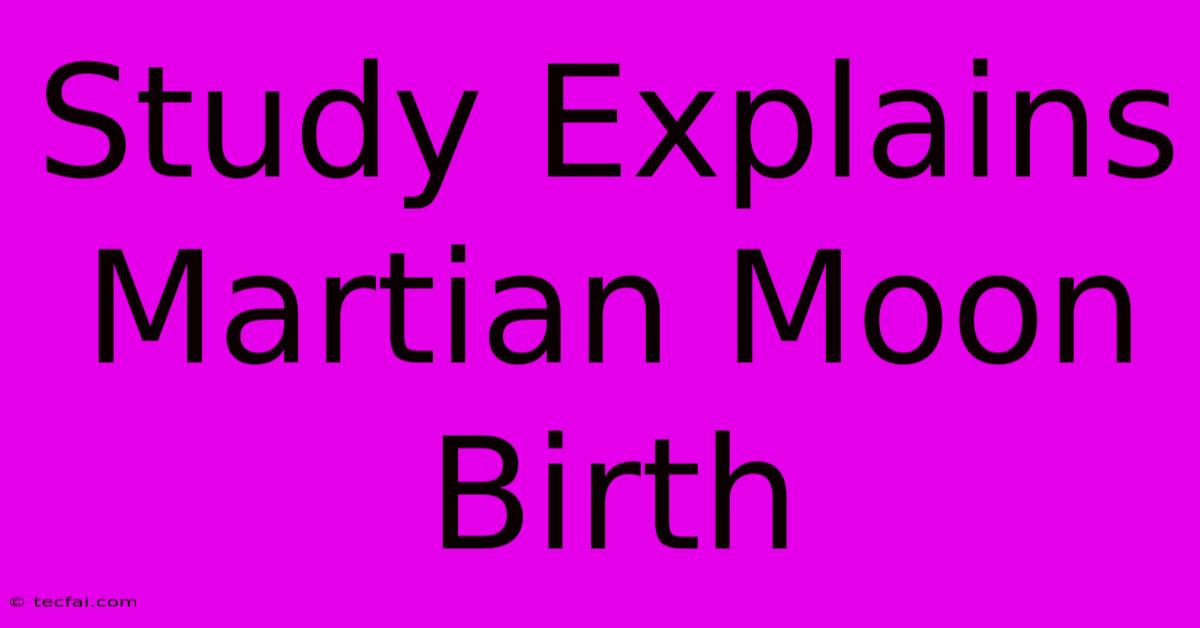Study Explains Martian Moon Birth

Discover more detailed and exciting information on our website. Click the link below to start your adventure: Visit Best Website tecfai.com. Don't miss out!
Table of Contents
Study Explains Martian Moon Birth: A Collision Course to Phobos and Deimos
The Martian moons, Phobos and Deimos, have long captivated scientists with their unusual characteristics. Unlike Earth's Moon, these small, irregularly shaped satellites don't quite fit the classic picture of moon formation. A recent study offers a compelling new explanation for their origin, suggesting a dramatic collision in Mars' early history played a crucial role. This article delves into the findings, exploring the implications for our understanding of planetary formation and the Martian system itself.
The Mystery of Phobos and Deimos
For decades, the prevailing theories for the formation of Phobos and Deimos revolved around two main ideas: capture and co-formation. The capture hypothesis suggested that Mars gravitationally captured these asteroids as they wandered through the early solar system. However, this explanation faced challenges in accounting for the moons' relatively circular orbits and their composition, which bears some similarities to Mars itself. Co-formation, on the other hand, proposed that Phobos and Deimos formed simultaneously with Mars from the same protoplanetary disk. This theory, however, struggles to explain the moons' distinct properties compared to the planet itself.
A New Collisional Narrative Emerges
The latest research proposes a more dynamic scenario: a massive impact event early in Mars' history. Instead of forming directly from the protoplanetary disk or being captured later, this study suggests that Phobos and Deimos are remnants of a colossal collision between Mars and a smaller, Mars-sized body. This impact would have ejected a significant amount of Martian material into orbit. This material would then gradually accrete, eventually forming the two moons we observe today.
Evidence Supporting the Collision Theory
The study's conclusions are supported by sophisticated computer simulations modeling this catastrophic impact. These simulations successfully reproduce the observed characteristics of Phobos and Deimos, including their irregular shapes, relatively small sizes, and orbital parameters. The simulations suggest that the collision would have produced a large amount of debris, creating a circum-Martian disk from which the moons formed through the process of accretion.
Compositional Clues and Similarities
Furthermore, the study notes a possible compositional link between the moons and Mars, supporting the idea of a common origin. While further research is needed to fully understand their precise composition, the initial similarities lend credence to the collision hypothesis.
Implications for Planetary Science
This new understanding of Phobos and Deimos' origin has important implications for our broader understanding of planetary formation. It highlights the significance of large-scale impacts in shaping planetary systems, offering insights into processes that may have been more common in the early solar system. The findings could also shed light on the formation of other planetary systems beyond our own.
Future Research and Exploration
Further investigation into the composition of Phobos and Deimos is crucial for confirming the hypothesis. Future missions to these moons, potentially involving sample return missions, will provide valuable data to test this new model and potentially refine our understanding of the Martian system's evolution.
Conclusion: A Dynamic Martian Past
The proposed collision scenario offers a compelling explanation for the origin of Phobos and Deimos, challenging previous theories and offering a new perspective on the dynamic and violent history of the Martian system. The ongoing research and future missions will provide further evidence to either strengthen or refine this intriguing new understanding of Mars' fascinating satellites. This study underlines the ongoing exploration and unraveling of planetary mysteries, a journey that continuously reshapes our knowledge of the cosmos.

Thank you for visiting our website wich cover about Study Explains Martian Moon Birth. We hope the information provided has been useful to you. Feel free to contact us if you have any questions or need further assistance. See you next time and dont miss to bookmark.
Featured Posts
-
Jon Benet Ramsey Netflixs Crucial Clue
Nov 26, 2024
-
Drake Accuses Label Of Bias
Nov 26, 2024
-
Storm Bert Damage Tenbury Wells In Pictures
Nov 26, 2024
-
Deodorant Fire Engulfs Champion Lakes
Nov 26, 2024
-
Iowa State Auburn Basketball Highlights
Nov 26, 2024
